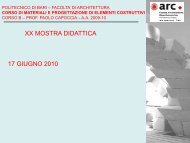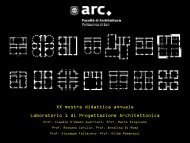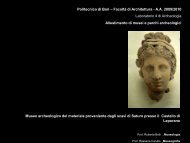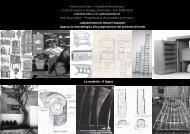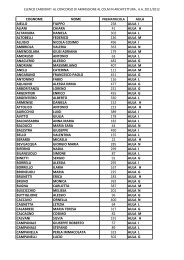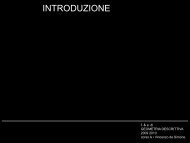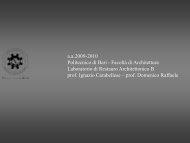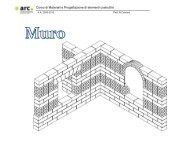44. I regolamenti <strong>di</strong>dattici62Storia dell’architettura greca + Storiadell’architettura <strong>di</strong> Magna Grecia e Sic<strong>il</strong>iaHistory of Greec Architecture + History of(Icar 18-7,5 cfu)1° anno / Corso annualeIn<strong>di</strong>rizzo ‘classico’Area <strong>di</strong>dattica II:Discipline storiche per l’architetturaGiorgio RoccoFinalità e contenuti <strong>di</strong>sciplinariObiettivo primario del corso è fornire glistrumenti metodologici necessari allalettura degli organismi architettonici nellaloro articolazione spaziale e costruttiva,analizzati nel loro sv<strong>il</strong>uppo <strong>di</strong>acronico enello specifico contesto ambientale. Laconoscenza degli eventi storici salientinell’ambito dell’età antica, insieme ad uncorretto inquadramento dei temi affrontatinelle relative coor<strong>di</strong>nate geografiche,costituisce, <strong>di</strong> conseguenza, <strong>il</strong> presuppostofondamentale <strong>di</strong> una correttainterpretazione delle realizzazioniarchitettoniche del periodo in esame.Aims and contentsThe primary objective of the course isacquiring the necessary methodologicaltools for rea<strong>di</strong>ng architectural organisms intheir spatial and constructive articulation,analyzed in their <strong>di</strong>achronicdevelopment and in their specificenvironmental context. The knowledge ofthe main historical events in the ancientage, together with correct organization ofthe themes faced in the relativegeographical coor<strong>di</strong>nates, constitutes thefundamental prerequisite for correctinterpretation the architecture of theexamined period.Argomenti delle lezioniPARTE I – ARCHITETTURA GRECA – Corsogenerale (primo semestre)Lezioni:– Le fonti per lo stu<strong>di</strong>o dell’architetturaantica. Il dato materiale. Il problema delladatazione. – Elementi <strong>di</strong> architetturapalaziale minoica e micenea. - La culturagreca nella madrepatria e in oriente: lanascita della polis. Influenze egiziane edorientali nella nascita dell’architetturagreca. - L’architettura dorica e ionica delleorigini: l’età geometrica, orientalizzante eprotoarcaica. - Architettura <strong>di</strong> età arcaica inGrecia.– Architettura <strong>di</strong> età arcaica nelle colonieoccidentali. – Architettura arcaica nelleCicla<strong>di</strong>. – Architettura arcaica in AsiaMinore. – Architettura <strong>di</strong> età classica inGrecia. – Architettura <strong>di</strong> età classica in nellecolonie occidentali. – Architettura tardoclassicain Grecia. - Architettura tardoclassicain Asia Minore. - L’architetturadell’ellenismo in Grecia e in Occidente. -L’architettura dell’ellenismo nelMe<strong>di</strong>terraneo orientale.Seminari:– Generalità sugli or<strong>di</strong>ni: l’or<strong>di</strong>ne dorico. -Generalità sugli or<strong>di</strong>ni: l’or<strong>di</strong>ne ionico. -Tecniche costruttive <strong>di</strong> età greca. - Ilsantuario: gli e<strong>di</strong>fici per <strong>il</strong> culto. - Gli e<strong>di</strong>ficiper gli agoni: teatri, odeia, sta<strong>di</strong> eippodromi. - L’agorà: stoai e organizzazionedello spazio. - Gli e<strong>di</strong>fici della politica:ekklesiasteria, bouleteuria, pritaneia,<strong>di</strong>kasteria. - Città spontanea e cittàpianificata. La casa tipo.Esercitazioni grafiche e scrittografiche.Parte II – Architettura greca – Corsomonografico: ‘I santuari greci’ (secondosemestre)Seminari:– Il santuario <strong>di</strong> Apollo a Delfi. – Il santuario<strong>di</strong> Athena a Delfi. - Il santuario <strong>di</strong> Zeus aOlimpia. - Il santuario <strong>di</strong> Zeus a Nemea. – Ilsantuario <strong>di</strong> Poseidone all’Isthmo. – Ilsantuario <strong>di</strong> Apollo a Delos. - Il santuario <strong>di</strong>Hera Lacinia a Capo Colonna. - Il santuariodei Gran<strong>di</strong> Dei a Samotracia. – Il santuario<strong>di</strong> Demetra ad Eleusi.Esercitazioni grafiche, scrittografiche ebibliografiche.Topics1st part – Greek architecture – Generalsection (1st semester)- The role of archeological, literary andepigraphical source in the study of ancientarchitecture. Archaeological evidence andcronology. - Elements of Minoic and Myceneanpalatial architecture. - The Greek culture in theMainland and in the east: the birth of thepolis. Egyptian influence in the origins ofGreek architecture. - The origin of Doric andIonic architecture: the geometric, orientalizingand protoarcaic period. - Archaic architecturein Greece. - Archaic architecture in westerncolonies. - Archaic architecture in theCyclades. - Archaic architecture in Asia Minor. -Classical architecture in Greece. - Classicalarchitecture in Western Colonies. - Lateclassicalarchitecture in Greece. - Lateclassicalarchitecture in Asia Minor. - TheHellenistic Architecture in Greece and in theWest. - The Hellenistic Architecture in the EastMe<strong>di</strong>terranean.Seminary- Generality on the architectural orders: thedoric order. - Generality on the architecturalorders: the ionic order. - Greek bu<strong>il</strong><strong>di</strong>ngtechniques. - The sanctuaries: the cultbu<strong>il</strong><strong>di</strong>ngs. - The bu<strong>il</strong><strong>di</strong>ng for the agones:theatres, odeion, sta<strong>di</strong>a, hyppodromes. - Theagora: stoai and planned space. - Thebu<strong>il</strong><strong>di</strong>ngs of politic: ekklesiasteria,bouleuteria, pritaneia, <strong>di</strong>kasteria. -Spontaneous city and planned city. The modelhouse.Written and graphic exercitations.Parte II – Greek architecture – Monograficsection: ‘The Greek Sanctuaries’ (secondsemester)Seminary- The sanctuary of Apollo at Delphi. - Thesanctuary of Athena at Delphi. - The sanctuaryof Zeus at Olympia. - The sanctuary of Zeus atNemea. - The sanctuary of Poseidon atIsthmus. - The sanctuary of Apollo at Delos. -The sanctuary of Hera Lacinia at CapoColonna. - The sanctuary of Gran<strong>di</strong> Dei atSamotracia. - The sanctuary of Demeter atEleusis.Written, graphic and bibliographicexercitations.Articolazione delle attività <strong>di</strong>datticheIl corso si articolerà in lezioni, destinate adaffrontare la materia in formarigorosamente <strong>di</strong>acronica, e seminari,orientati ad analizzare in formaprevalentemente tematica aspetti specificirelativi agli argomenti affrontati; sarannoeffettuate inoltre esercitazioni grafiche ecrittografiche nonché esercitazioni
ibliografiche, volte ad acquisire glistrumenti e la metodologia necessari acondurre ricerche bibliografiche.Articulation of educational activitiesThe course w<strong>il</strong>l be articulated in lectures,intended to <strong>di</strong>splay the matter in a<strong>di</strong>acronical manner, and seminaries,oriented to analyze in a thematic mannerspecific aspects; the course includes alsographic and written exercitations andexercises in library, necessary to acquireinstruments and methodology to carry outbibliographical searches.Iscrizione al corsoLe iscrizioni avvengono obbligatoriamentesulla piattaforma entro i primi <strong>di</strong>eci giornidall’inizio dei corsi.Ammissione all’esame e sua modalità <strong>di</strong>svolgimentoLa partecipazione alle attività <strong>di</strong>dattiche èin<strong>di</strong>spensab<strong>il</strong>e per poter usufruire dellapossib<strong>il</strong>ità <strong>di</strong> sostenere l’esame finale.In sede <strong>di</strong> esame sarà valutata laconoscenza e la capacità <strong>di</strong> valutazionestorico-critica della materia, attraverso uncolloquio ed eventualmente semplici<strong>di</strong>segni a mano libera eseguiti davanti allacommissione, a chiarimento degliargomenti proposti dagli esaminatori.Materiali e progettazione <strong>di</strong> elementicostruttiviMaterials and elements of bu<strong>il</strong><strong>di</strong>ng designIcar 12-9 cfu1° anno / Corso annualein<strong>di</strong>rizzo ‘generale’Area <strong>di</strong>dattica V:Discipline tecnologiche per l’architetturaCorso AVanda Rosa SaviCorso BGiorgio BlancoCorso CRiccardo CalvanoFinalità e contenuti <strong>di</strong>sciplinariObiettivo è l’appren<strong>di</strong>mento da parte dellostudente dei meto<strong>di</strong> e degli strumentinecessari alla comprensione del rapportofra processo <strong>di</strong> progettazione e processo <strong>di</strong>costruzione. In tal modo l’allievo potràavere da una parte una visione globaledelle problematiche connesse con l’arte delcostruire; e dall’altra conoscere in chemisura i materiali e le relative tecnologied’impiego possono tradurre in realtàl’ipotesi progettuale.Aims and educational contentsThe objective is learning the methods andnecessary tools to understand therelationship between design andconstruction of architecture. In this way thestudent can have on one hand a globalvision of the problems connected with theart of the bu<strong>il</strong><strong>di</strong>ng; and on the other handknow how materials and technology can beemployed to realise the project hypothesis.Argomenti delle lezioniPrima parte- La concezione sistemica (ambientale etecnologica) dell’e<strong>di</strong>ficio.- La qualità ed<strong>il</strong>izia e i sistemi normativi.- Il processo produttivo dalla materia almateriale all’elemento d’architettura.- Struttura, costituzione, composizione eproprietà dei materiali.- Le proprietà meccaniche: comportamentostatico, materiali rigi<strong>di</strong> ed elastici, legge <strong>di</strong>Hooke, vincoli e sollecitazioni.- La concezione strutturale: <strong>il</strong> tr<strong>il</strong>ite, lavolta, <strong>il</strong> telaio.- Energia raggiante: qualità e trasmissione;energia sonora: sua propagazione.- Proprietà termiche: leggi dellatermo<strong>di</strong>namica e modalità <strong>di</strong> trasmissionedel calore.Seconda parte- Il concetto <strong>di</strong> sostenib<strong>il</strong>ità.- I materiali lapidei e i relativi elementicostruttivi.- I materiali ceramici e i relativi elementicostruttivi.- Leganti, malte, intonaci e calcestruzzi e irelativi elementi costruttivi.- I materiali metallici e i relativi elementicostruttivi.- Il conglomerato cementizio armato e irelativi elementi costruttivi.- Il vetro: infissi e tramezzi.- Il legno e i relativi elementi costruttivi.- Isolanti e impermeab<strong>il</strong>izzanti.Topics1st Part- The systematic conception (environmentaland technological) of the bu<strong>il</strong><strong>di</strong>ng.- The b<strong>il</strong><strong>di</strong>ng quality and the normativesystems.- The productive process: from the matterto the material, to the architecture element.- Proprerties and characteristics of thematerials.- Mechanical properties: static behaviour,rigid and elastic materials, Hooke’s law,ties and sollecitations.- The structural conception: the tr<strong>il</strong>ithon,the voult, the frame.- Ra<strong>di</strong>ant energy: quality and transmission;resonant energy: its propagation.- Thermic properties: laws of thethermodynamics and form of the heat’stransmission.2nd Part- Tollerableness’ concept.- The stony materials.- The earthenwares.- Binder, mortars, plasters and concretes.- The metallic materials.- The reinforced concrete.- The glass: frames and partitions.- The wood.- The insulatings and waterproofingmaterials.Articolazione delle attività <strong>di</strong>datticheI corsi si svolgono attraverso lezioniteoriche, seminari <strong>di</strong> approfon<strong>di</strong>mento edesercitazioni grafiche <strong>di</strong> applicazione deitemi trattati a lezione.Articulation of educational activitiesThe courses are developed through44.2.9 Progetti <strong>di</strong>dattici del I ciclo del CdLm in Architettura63
- Page 1:
0607Politecnico di BariFacoltà di
- Page 4 and 5:
Politecnico di Bari, Facoltà di Ar
- Page 6 and 7:
4. Regolamenti didattici4.1. Il Reg
- Page 8 and 9:
PresentazionePresentazioneLa Facolt
- Page 11 and 12:
Le strutture didattiche e di suppor
- Page 13 and 14: giorno e dando, quindi, esecutivit
- Page 15 and 16: • esprimere pareri sui compiti di
- Page 17 and 18: 1.3. La Biblioteca di FacoltàIl pa
- Page 19 and 20: 2. Strutture di ricerca e di suppor
- Page 21 and 22: BIO 07, Ecologia43 Mariavaleria Min
- Page 23 and 24: le richieste e le iniziative ad ess
- Page 25: 2.3 Le biblioteche d’area2.3.1 Le
- Page 28 and 29: 33. La didattica e gli studenti263.
- Page 31 and 32: 4. I Regolamenti didattici4.1. Rego
- Page 33 and 34: presente regolamento;• le propede
- Page 35 and 36: discussi ed i voti finali.Per ciasc
- Page 37 and 38: 4.2.4 Definizione delle aree discip
- Page 39 and 40: laurea da attivare in base al numer
- Page 41 and 42: non venga superato l’iscrizione a
- Page 43 and 44: Manifesto del CdLs in Architettura
- Page 45 and 46: Manifesto del CdLm in Architettura
- Page 47 and 48: ciclo provenendo da altri Atenei.È
- Page 49 and 50: Manifesto del CdLs in Architettura
- Page 51 and 52: Manifesto del CdLm in Architettura
- Page 53 and 54: Insegnamenti ssd Crediti Laboratori
- Page 55 and 56: Insegnamenti ssd Crediti Laboratori
- Page 57 and 58: Insegnamenti attivati e docenti per
- Page 59 and 60: Insegnamenti attivati e docenti per
- Page 61 and 62: Finalità e contenuti disciplinariN
- Page 63: Lezioni- L’architettura etrusca e
- Page 67 and 68: Discipline tecnologiche per l’Arc
- Page 69 and 70: Istituzioni di geometria I + Istitu
- Page 71 and 72: architettonicoTopicsLife drawing, u
- Page 73 and 74: • Representation of the shadows
- Page 75 and 76: frequenza del corso che consentel
- Page 77 and 78: capacità di valutazione storico-cr
- Page 79 and 80: scale edilizie e tra diversi tipi;
- Page 81 and 82: planning of Roman suburban andcount
- Page 83 and 84: mutation through the works of the p
- Page 85 and 86: -Equazioni indefinite di equilibrio
- Page 87 and 88: coerenza tra qualità funzionale, c
- Page 89 and 90: transformations (psychrometry).In t
- Page 91 and 92: madrepatria.4. La colonizzazione e
- Page 93 and 94: EtruscologiaEtruscologyL-ANT/07 - 4
- Page 95 and 96: Archeologia e Storia dell’Arte Ro
- Page 97 and 98: The student will develope the archi
- Page 99 and 100: tanto il rapporto tra elementi, str
- Page 101 and 102: sociale dell’abitare (Loos, Tesse
- Page 103 and 104: experimental research into the beha
- Page 105 and 106: Articolazione dell’attività dida
- Page 107 and 108: Aims and contentsThe Urban Sociolog
- Page 109 and 110: nell’ambito dell’annuale “mos
- Page 111 and 112: di laurea. Sarà quindi necessario
- Page 113 and 114: - Ancient modern Rome: the continui
- Page 115 and 116:
During the lessons, theoretical and
- Page 117 and 118:
Le esercitazioni costituiscono lo s
- Page 119 and 120:
typological and technical innovatio
- Page 121 and 122:
• la fenomeni di propagazione del
- Page 123 and 124:
Aims and contentsThe urban economy,
- Page 125 and 126:
value of a civil apartment with the
- Page 127 and 128:
l’elaborazione della tesi di rice
- Page 129 and 130:
4.3.8 Esame di laureaPer essere amm
- Page 131 and 132:
semestrale• Laboratori di sintesi
- Page 133 and 134:
4.3.14 Manifesto del CdL in Disegno
- Page 135 and 136:
4.3.16 Organizzazione delle attivit
- Page 137 and 138:
4.3.17 Insegnamenti e docenti per a
- Page 139 and 140:
Laboratorio di Disegno industriale
- Page 141 and 142:
• metodo dell’assonometria;•
- Page 143 and 144:
fine dell’Ottocento; le avanguard
- Page 145 and 146:
Iscrizione al corsoLe iscrizioni av
- Page 147 and 148:
Laboratorio di Arredamento 2/IInter
- Page 149 and 150:
Disegno 2/IIDrawing 2/IIIcar 17-5 c
- Page 151 and 152:
communication, as follows:• typog
- Page 153 and 154:
4.3.22 Progetti didattici3° anno
- Page 155 and 156:
sintetiche, segnaletica interna ed
- Page 157:
esercitazioni pratiche, attività d
- Page 160 and 161:
55. Relazioni internazionali1585.1
- Page 163 and 164:
6. Post Lauream6.1. Dottorato di Ri
- Page 165 and 166:
Attività di ricercaLo svolgimento
- Page 167 and 168:
particolari e specifiche competenze
- Page 169 and 170:
iscrizione all’esame di ammission
- Page 171 and 172:
scientifico-disciplinare in cui è
- Page 173:
• alla sicurezza statica (corrett
- Page 176 and 177:
a.1 Planimetria del campus epiante
- Page 178 and 179:
Status accademico dei docentiDocent
- Page 180 and 181:
aAppendici178A.3 Indice dei nomiAAc
- Page 182 and 183:
aAppendicia.5 Calendario annuale de




